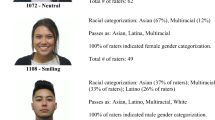Abstract
People view men as typically human, although some conditions may make this more or less likely. Language has been implicated as one factor, with masculine generic language (e.g., he used neutrally) leading to more androcentrism relative to its alternatives. However, the influence of two types of alternatives (e.g., they vs. he or she) remains unclear. The present study asked 297 male and female online participants from the United States to select typical representations of humanity from a set of White and Black male and female faces. The wording for the concept humanity was manipulated to be either a typical member of mankind, a typical human, or a typical man or woman (or woman or man). Overall, participants selected more White targets. Participants also selected more male targets, but the degree to which that was the case was affected by wording and participant’s gender. Participants, particularly male participants, in the mankind and human wording conditions were more likely to select a male target as representative, whereas in the man or woman condition, participants’ choices did not differ from chance. Thus, androcentric thinking may be more mutable than previously surmised, varying by participants’ gender and by context.




Similar content being viewed by others
References
American Psychological Association Publication Manual Task Force (1978). Guidelines for non-sexist language in APA journals: Publication manual change sheet 2. Educational Researcher, 7(3), 487–494.
Beery, T. A. (1995). Gender bias in the diagnosis and treatment of coronary artery disease. Heart & Lung: The Journal of Acute and Critical Care, 24(6), 427–435. doi:10.1016/S0147-9563(95)80020-4.
Bem, S. L. (1993). The lenses of gender: Transforming the debate on sexual inequality. New Haven, CT: Yale University.
Bem, S. L. (1995). Dismantling gender polarization and compulsory heterosexuality: Should we turn the volume down or up? The Journal of Sex Research, 32(4), 329–334. doi:10.1080/00224499509551806.
Bodine, A. (1975). Androcentrism in prescriptive grammar: Singular ‘they,’ sex-indefinite ‘he,’ and ‘he or she.’. Language in Society, 4(2), 129–146. doi:10.1017/S0047404500004607.
Brooks, R. R. W., & Purdie-Vaughns, V. (2007). Supermodular architecture of inclusion. Harvard Journal of Law and Gender, 30, 379–386.
Broverman, I. K., Broverman, D. M., Clarkson, F. E., Rosenkrantz, P. S., & Vogel, S. R. (1970). Sex-role stereotypes and clinical judgements of mental health. Journal of Consulting and Clinical Psychology, 34(1), 1–7. doi:10.1037/h0028797.
Burke, S. E., & LaFrance, M. (2015). Lay conceptions of sexual minority groups. Archives of Sexual Behavior. Advance online publication. doi:10.1007/s10508-015-0655-5.
Center for American Women and Politics. (2013). Women in the U.S. Congress 2013. Retrieved from http://www.cawp.rutgers.edu/fast_facts/levels_of_office/documents/cong.pdf.
Cohen, J. (1992). A power primer. Psychological Bulletin, 112(1), 155–159. doi:10.1037/0033-2909.112.1.155.
Crosby, F., Clayton, S., Alksnis, O., & Hemker, K. (1986). Cognitive biases in the perception of discrimination: The importance of format. Sex Roles, 14(11/12), 637–646. doi:10.1007/BF00287694.
Cundiff, J. L. (2012). Is mainstream psychological research womanless and raceless? An updated analysis. Sex Roles, 67(3–4), 158–173.
de Beauvoir, S. (2010). The second sex. (Trans: C. Borde & S. Malovany-Chevallier). New York: Vintage Books. (Original work published 1949).
Eagly, A. H., & Kite, M. E. (1987). Are stereotypes of nationalities applied to both women and men? Journal of Personality and Social Psychology, 53(3), 451–462. doi:10.1037/0022-3514.53.3.451.
Eagly, A. H., Wood, W., & Diekman, A. B. (2000). Social role theory of sex differences and similarities: A current appraisal. In T. Eckes & H. M. Trautner (Eds.), The developmental social psychology of gender (pp. 123–174). New Jersey: Lawrence Erlbaum Associates, Publishers.
Faul, F., Erdfelder, E., Lang, A. G., & Buchner, A. (2007). G* power 3: A flexible statistical power analysis program for the social, behavioral, and biomedical sciences. Behavior Research Methods, 39(2), 175–191. doi:10.3758/BF03193146.
Fausto-Sterling, A. (1993). The five sexes. The Sciences, 33(2), 20–24.
Fiske, S. T., & Stevens, L. E. (1993). What's so special about sex? Gender stereotyping and discrimination. In S. Oskamp & M. Costanzo (Eds.), Gender issues in contemporary society: Applied social psychology annual (pp. 173–196). Newbury Park: Sage.
Gastil, J. (1990). Generic pronouns and sexist language: The oxymoronic character of masculine generics. Sex Roles, 23(11), 629–643. doi:10.1007/BF00289252.
Ginther, D. K., & Kahn, S. (2009). Does science promote women? Evidence from academia 1973–2001. In R. B. Freeman & D. F. Goroff (Eds.), Science and engineering careers in the United States: An analysis of markets and employment (pp. 163–194). Chicago: University of Chicago Press.
GLAAD. (2015). Tips for allies of transgender people. Retrieved from http://www.glaad.org/transgender/allies.
Glick, P., & Fiske, S. T. (2001). An ambivalent alliance: Hostile and benevolent sexism as complementary justifications for gender inequality. American Psychologist, 56(2), 109–118.
Grant, J. M., Mottet, L., Tanis, J. E., Harrison, J., Herman, J., & Keisling, M. (2011). Injustice at every turn: A report of the national transgender discrimination survey. Washington, DC: National Center for Transgender Equality.
Hamilton, M. C. (1991). Masculine bias in the attribution of personhood: People = male, male = people. Psychology of Women Quarterly, 15, 393–402. doi:10.1111/j.1471-6402.1991.tb00415.x.
Hegarty, P., & Buechel, C. (2006). Androcentric reporting of gender differences in APA journals: 1964-2004. Review of General Psychology, 10(4), 377–389. doi:10.1037/1089-2680.10.4.377.
Hunt, E., & Agnoli, F. (1991). The Whorfian hypothesis: A cognitive psychology perspective. Psychological Review, 98(3), 377–389. doi:10.1037/0033-295X.98.3.377.
Hyde, J. S. (1984). Children’s understanding of sexist language. Developmental Psychology, 20(4), 697–706. doi:10.1037/0012-1649.20.4.697.
Kahneman, D., & Miller, D. T. (1986). Norm theory: Comparing reality to its alternatives. Psychological Review, 93(2), 136–153. doi:10.1037/0033-295X.93.2.136.
Lambdin, J. R., Greer, K. M., Jibotian, K. S., Wood, K. R., & Hamilton, M. C. (2003). The animal = male hypothesis: Children’s and adults’ beliefs about the sex of non-sex-specific stuffed animals. Sex Roles, 48(11/12), 471–482. doi:10.1023/A:1023567010708.
LGBTQ Resource Center. (2015). Gender pronouns. Retrieved from https://uwm.edu/lgbtrc/support/gender-pronouns/.
Linville, P. W., & Fischer, G. W. (1993). Exemplar and abstraction models of perceived group variability and stereotypicality. Social Cognition, 11(1), 92–125. doi:10.1521/soco.1993.11.1.92.
Ma, D. S., Correll, J., & Wittenbrink, B. (2015). The Chicago face database: A free stimulus set of faces and norming data. Behavior Research Methods, 47, 1122–1135. doi:10.3758/s13428-014-0532-5.
Madson, L., & Hessling, R. M. (1999). Does alternating between masculine and feminine pronouns eliminate perceived gender bias in text? Sex Roles, 41(7/8), 559–575. doi:10.1023/A:1018895321444.
Miller, M. M., & James, L. E. (2009). Is the generic pronoun he still comprehended as excluding women? The American Journal of Psychology, 122(4), 483–496.
Miller, D. T., Taylor, B., & Buck, M. L. (1991). Gender gaps: Who needs to be explained? Journal of Personality and Social Psychology, 61(1), 15–21. doi:10.1037/0022-3514.61.1.5.
Moss-Racusin, C. A., Dovidio, J. F., Brescoll, V. L., Graham, M. J., & Handelsman, J. (2012). Science faculty’s subtle gender biases favor male students. Proceedings of the National Academy of Sciences, 109(41), 16474–16479. doi:10.1073/pnas.1211286109.
Moulton, J., Robinson, G. M., & Elias, C. (1978). Psychology in action: sex bias in language use: “Neutral” pronouns that aren’t. American Psychologist, 33, 1032–1036. doi:10.1037/0003-066X.33.11.1032.
Ng, S. H. (1989). Androcentric coding of man and his in memory by language users. Journal of Experimental Social Psychology, 26, 455–464. doi:10.1016/0022-1031(90)90069-X.
Prentice, D. A. (1994). Do language reforms change our way of thinking? Journal of Language and Social Psychology, 13, 3–19. doi:10.1177/0261927X94131001.
Schneider, J. W., & Hacker, S. L. (1973). Sex role imagery and use of the generic “man” in introductory texts: A case in the sociology of sociology. The American Sociologist, 8(1), 12–18.
Silveira, J. (1980). Generic masculine words and thinking. Women’s Studies International Quarterly, 3, 165–178. doi:10.1016/S0148-0685(80)92113-2.
Smith, E. R., & Zárate, M. A. (1992). Exemplar-based model of social judgment. Psychological Review, 99(1), 3–21. doi:10.1037/0033-295X.99.1.3.
Stangor, C., Lynch, L., Duan, C., & Glas, B. (1992). Categorization of individuals on the basis of multiple social features. Journal of Personality and Social Psychology, 62(2), 207–218. doi:10.1037/0022-3514.62.2.207.
Stroessner, S. J. (1996). Social categorization by race or sex: Effects of perceived non-normalcy on response times. Social Cognition, 14(3), 247–276. doi:10.1521/soco.1996.14.3.247.
Switzer, J. Y. (1990). The impact of generic word choices: An empirical investigation of age- and sex-related differences. Sex Roles, 22(1/2), 69–81. doi:10.1007/BF00288155.
Tajfel, H., & Turner, J. C. (1979). An integrative theory of intergroup conflict. In W. G. Austin & S. Worchel (Eds.), The social psychology of intergroup relations (pp. 33–47). Monterey: Brooks/Cole.
Twenge, J. M. (2012). Male and female pronoun use in U.S. books reflects women’s status, 1900-2008. Sex Roles, 69(9–10), 488–493. doi:10.1007/s11199-012-0194-7.
Uddenberg, S., & Scholl, B. (2015). Revealing mental defaults in face space with serial reproduction. Journal of Vision, 15(12), 1214–1214. doi:10.1167/15.12.1214.
United States Department of Labor. (2015). Women in the labor force. Retrieved from http://www.dol.gov/wb/stats/facts_over_time.htm#content.
Williams, W. M., & Ceci, S. J. (2015). National hiring experiments reveal 2:1 faculty preference for women on STEM tenure track. Proceedings of the National Academy of Sciences, 112(17), 5360–5365. doi:10.1073/pnas.1418878112.
Winter, J., & Pauwels, A. (2006). Men staying at home looking after their children: Feminist linguistic reform and social change. International Journal of Applied Linguistics, 16(1), 16–36. doi:10.1111/j.1473-4192.2006.00104.x.
Wohl, M. J. A., & Branscombe, N. R. (2005). Forgiveness and collective guilt assignment to historical perpetrator groups depend on level of social category inclusiveness. Journal of Personality and Social Psychology, 88(2), 288–303. doi:10.1037/0022-3514.88.2.288.
Zárate, M. A., & Smith, E. R. (1990). Person categorization and stereotyping. Social Cognition, 8(2), 161–185. doi:10.1521/soco.1990.8.2.161.
Acknowledgments
The authors would like to acknowledge the Yale University Psychology Department for providing funding for the project.
Author information
Authors and Affiliations
Corresponding author
Ethics declarations
The present research involves human subjects; as detailed in the manuscript, the research was reviewed and approved by the Yale Human Subjects Committee.
Conflict of Interest
The authors declare that they have no conflict of interest.
Electronic Supplementary Material
ESM 1
(DOCX 13 kb)
Rights and permissions
About this article
Cite this article
Bailey, A.H., LaFrance, M. Who Counts as Human? Antecedents to Androcentric Behavior. Sex Roles 76, 682–693 (2017). https://doi.org/10.1007/s11199-016-0648-4
Published:
Issue Date:
DOI: https://doi.org/10.1007/s11199-016-0648-4




